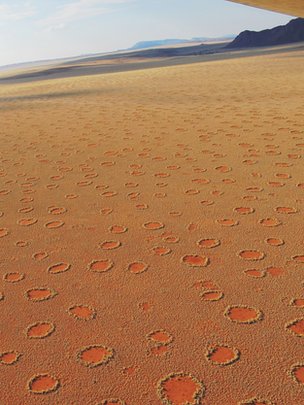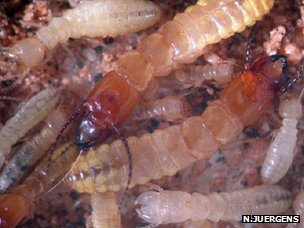 A German scientist thinks he can now explain the strange rings of grass that cover great swathes of desert-margin land in southwestern Africa.
A German scientist thinks he can now explain the strange rings of grass that cover great swathes of desert-margin land in southwestern Africa.
These so-called fairy circles have variously been pinned on the presence of other, poisonous plants, on ants, and even toxic gases rising from below.
But Norbert Juergens says the one ever-present factor is sand termites.
The creatures have engineered the rings to maintain a supply of water in their environment,he tells Science magazine.
The University of Hamburg researcher has been studying fairy circles for many years, examining hundreds of them in detail.
He reports how the invertebrates (Psammotermes allocerus) first clear a patch of ground by eating the roots of short-lived, annual grasses.
This bare, sandy earth then becomes an effective rain trap - with no vegetation, water cannot be lost through transpiration (the evaporation of water from plants).
Instead, it collects, oasis-like, just below the surface where it can sustain the termites and a supply of perennial grasses at the margins of the circles. These are available to eat even in the driest seasons.
The regime, says Prof Juergens, also drives wider benefits, with the insects becoming a valuable food resource for a whole range of other animals such as geckos, moles, aardvarks, jackals, spiders, ants and the like.
Beaver beater
The Hamburg scientist argues that the termites' behaviour surpasses the accomplishments of that other great ecosystem engineer - the beaver.
"We all admire the beaver for the way it can turn a linear river into a lake with a dam, but the termites turning the desert into a pattern of oases that allow permanent life even in drought periods for hundreds of years - that's much more fascinating," he told BBC News.
 P. allocerus - even more remarkable than the beaver
P. allocerus - even more remarkable than the beaver
"What is more, these termites do it on a large scale - over hundreds of square kilometres. They should replace the beaver as the text-book engineer."
Fairy circles appear in a narrow belt that skirts the eastern edge of the Namib Desert from Angola to South Africa.
They have long fascinated foreign researchers, especially from Europe.
The name is almost certainly derived from the terms used to describe the rings of mushrooms often seen in forested areas. In Germany, for example, such fungi circles are known as "hexenring" - "witches' rings".
Prof Juergens says climate is a key controlling parameter in the location of the African features.
He notes how their occurrence hugs the isohyet of 100mm mean annual precipitation.
"It's very pronounced; they're really adapted to that amount of annual precipitation," he told BBC News. "If the climate changed [to wetter conditions], this belt of occurrence would shift to a more arid part of the desert. If the climate got drier in general, they would shift towards the east, inland."
Rival ideas still abound for the circles' formation. Some researchers still maintain they are just a natural pattern adopted by vegetation when competing for scarce resources.